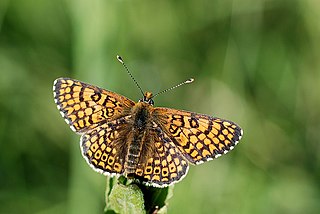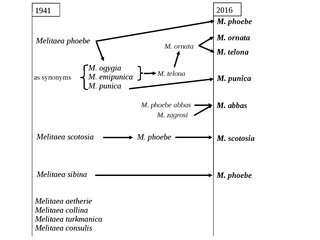
The Glanville fritillary is a butterfly of the family Nymphalidae. It is named for the naturalist who discovered it and the checkerboard pattern on its wings. These butterflies live in almost all of Europe, especially Finland, and in parts of northwest Africa. They are absent from the far north of Europe and parts of the Iberian Peninsula. To the east they are found across the Palearctic.

The heath fritillary is a butterfly of the family Nymphalidae. It is found throughout the Palaearctic from western Europe to Japan, in heathland, grassland, and in coppiced woodland. Its association with coppiced woodland earned it the name "woodman's follower" in parts of the UK. It is considered a threatened species in the UK and Germany, but not Europe-wide or globally.

Melitaea diamina, the false heath fritillary, is a butterfly of the family Nymphalidae.

Celastrina is a genus of butterflies in the family Lycaenidae found in the Palearctic, Nearctic, Indomalayan and Australasian realms.

Melitaea didyma, the spotted fritillary or red-band fritillary, is a Palearctic butterfly of the family Nymphalidae.

Melitaea phoebe, the knapweed fritillary, is a butterfly of the family Nymphalidae. It is found in the Palearctic realm, except the northernmost locations. It used to include Melitaea telona, recently revalidated as a distinct cryptic species.

Melitaea ornata, the eastern knapweed fritillary, is a butterfly in the family Nymphalidae. The species rank of Melitaea ornata was only very recently recognised by two research groups independently. They realized that there was an unrecognised species in Europe under the name of M. phoebe. The separation of this cryptic species was based on larval morphology from the fourth instar onwards. M. phoebe larvae have a black head capsule while the larvae of this recently recognised Ponto-Mediterranean species have a brick-red head capsule. The separation of the two taxa was also supported by the results of enzyme electrophoresis study. Based on these observations, the name M. telona Fruhstorfer was taken into use for this species. In a recent molecular study, the M. phoebe group forms a monophyletic clade within the subgenus Didymaeformia. Although that study provided important results regarding the systematics of the genus, the members of the phoebe species group were poorly represented, and the need for a detailed examination of this group remained. One of the important results was the corroboration of the species rank of M. telona and the suggestion that the taxon punica may represent a separate species from both M. telona and M. phoebe. Another recent study on the morphometry of genitalia in males and females of the phoebe species group provided additional information. An analysis of a large number of specimens from the Palaearctic showed that Melitaea telona is not restricted to the Ponto-Mediterranean region since several new localities were found, including the Orenburg region (Russia), northern Iran and the easternmost border of Kazakhstan. Since the name ornata described by Hugo Theodor Christoph in 1893 is older than the name telona, the authors began to use M. ornata as the valid name for this species following the rule of priority. Recently, it has also been indicated that M. telonasensu stricto from Israel and M. ornata are different taxa. Previous morphometrical studies have already revealed small differences in the genital structures of the males but the authors interpreted the difference as a well-pronounced intra-specific difference. In contrast, molecular data clearly showed that the two taxa are genetically distinct from each other. Based on the results of the analysis of seven genes, Tóth et al. (2014) concluded that M. telona is not a subspecies of M. ornata but a species in its own right.

Melitaea protomedia is a butterfly of the family Nymphalidae. It is found in the Amur River basin in Russia and from central and eastern China to Korea and Japan. The habitat consists of flowering meadows, forest edges and clearings.

Melitaea persea is a butterfly of the family Nymphalidae. It is found from Iran and Asia Minor to Afghanistan and the western parts of the Tian Shan mountains.

Melitaea centralasiae is a butterfly of the family Nymphalidae. It is found in eastern Russia and northern Mongolia.

Melitaea didymoides is a butterfly of the family Nymphalidae. It is found in Russia as well as in Mongolia and China. The habitat consists of dry meadows and xerothermic slopes with thin vegetation.

Jamides cyta, the pale cerulean, is a butterfly of the lycaenids or blues family. It is found throughout South-east Asia, from Malaysia to the Solomon Islands and the Philippines, as well as Queensland in Australia.

Lethe latiaris , the pale forester, is a species of Satyrinae butterfly found in the Indomalayan realm














